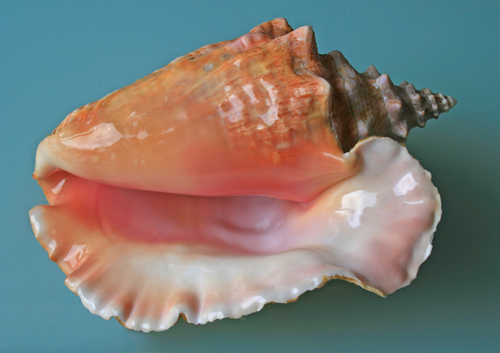Super shells

The prestigious evolutionary journal Nature marvelled at the giant conch shell. Nature said that this shell is ‘one of nature’s greatest engineering masterpieces’.1 So what makes it so special?
The animal grows its shell by first depositing an organic outer layer called the periostracum. This forms a base for tiny elongated crystals to grow, pointing at right-angles to the membrane. This layer is only one micron (1/25,000 inch) thick. So more mineral grows on top to a thickness of a few millimetres (about 1/8 inch).
This has a three-layered criss-crossing structure. It comprises rods of aragonite, a form of calcium carbonate (CaCO3), held together by protein glue. This makes a shell with 99% mineral and 1% protein. The rods in each layer line up at 90° to those in the adjoining layer. Further, each rod is composed of even smaller rods, and these comprise rods that are smaller still. And so on, down to individual crystals.2
Dr Roberto Ballarini, Material Science Engineer at Case Western Reserve University, investigated the shell’s strength. He showed that its arrangement makes it hard for a crack to travel through the entire structure. So although aragonite is very brittle, the architecture means that it is ‘one of the toughest brittle-natured composites known to man’. In fact, it’s 30 times stronger and about 1,000 times tougher (more resistant to fracturing) than the pure mineral.3 He hopes to be able to copy this structure ‘for small electronic hardware to make it tougher and more resilient’.2
And the living conch does something no man-made material can do—repair itself. Dr Ballarini’s colleague, Dr Su Xiao-Wei, has shown how the conch repairs holes. Within 24 hours, the conch seals a wound with a transparent membrane. Then it deposits tiny aragonite crystals, forming many fine layers. Only then, after 6–8 days, does the conch deposit the elongated crystals followed by the amazingly tough cross-layered structure.1
The repair process requires fine coordination of the organic and mineral layers. Dr Su and colleagues hope that their research will show how to design tough man-made materials. However, they still need to find out how this process is controlled at the molecular level. And when they discover the way the genes program this, they will learn yet another lesson from the Programmer (cf. Romans 1:18–23).
Re-posted on homepage: 19 July 2017
References and notes
- Daw, R., Give a shell a break, Nature 427(6976):691, 19 February 2004. Return to text.
- Ballarini, R., Cracking the conch conundrum: tough ceramics at the seashore, Distinguished Lecture Series, Cornell University, tc.cornell.edu, accessed February 2003. Return to text.
- Queen conch shell suggests new structure for ceramics, cwru.edu, accessed June 2000; based on Kamat, S., Su, X., Ballarini, R. and Heuer, A.H., Structural basis for the fracture toughness of the shell of the conch Strombus gigas, Nature 405(6790):1036–1040, 29 June 2000. Return to text.





Readers’ comments
Comments are automatically closed 14 days after publication.